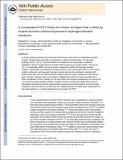Comparative PCET Study of a Donor−Acceptor Pair Linked by Ionized and Nonionized Asymmetric Hydrogen-Bonded Interfaces
Author(s)
Young, Elizabeth R.; Rosenthal, Joel; Hodgkiss, Justin M.; Nocera, Daniel G.
DownloadNocera_Comparative PCET.pdf (554.5Kb)
PUBLISHER_POLICY
Publisher Policy
Article is made available in accordance with the publisher's policy and may be subject to US copyright law. Please refer to the publisher's site for terms of use.
Terms of use
Metadata
Show full item recordAbstract
A Zn(II) amidinium porphyrin is the excited-state electron donor (D) to a naphthalene diimide acceptor (A) appended with either a carboxylate or sulfonate functionality. The two-point hydrogen bond (···[H[superscript +]]···) formed between the amidinium and carboxylate or sulfonate functionalities establishes a proton-coupled electron transfer (PCET) pathway for charge transfer. The two D···[H[superscript +]]···A assemblies differ only by the proton configuration within the hydrogen-bonding interface. Specifically, the amidinium ion transfers a proton to the carboxylate to form a nonionized amidine−carboxylic acid two-point hydrogen network, whereas the amidinium retains both protons when bound to the sulfonate functionality, forming an ionized amidinium−sulfonate two-point hydrogen bond network. These two interface configurations within the dyads thus allow for a direct comparison of the PCET kinetics for the same donor and acceptor juxtaposed by ionized and nonionized hydrogen-bonded interfaces. Analysis of the PCET kinetics ascertained from transient absorption and transient emission spectroscopy reveals that the ionized interface is more strongly impacted by the local solvent environment, thus establishing that the initial static configuration of the proton interface is a critical determinant in the kinetics of PCET.
Date issued
2009-05Department
Massachusetts Institute of Technology. Department of ChemistryJournal
Journal of the American Chemical Society
Publisher
American Chemical Society (ACS)
Citation
Young, Elizabeth R., Joel Rosenthal, Justin M. Hodgkiss, and Daniel G. Nocera. “Comparative PCET Study of a Donor−Acceptor Pair Linked by Ionized and Nonionized Asymmetric Hydrogen-Bonded Interfaces.” Journal of the American Chemical Society 131, no. 22 (June 10, 2009): 7678-7684.
Version: Author's final manuscript
ISSN
0002-7863
1520-5126